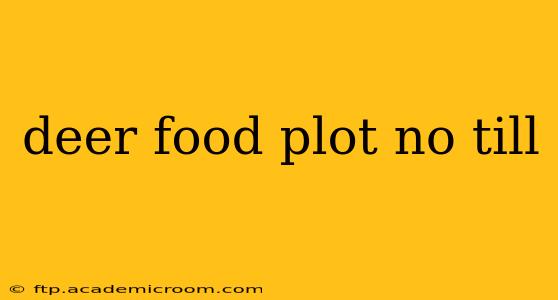Creating a thriving deer food plot doesn't require the backbreaking work of traditional tillage. No-till methods offer a more sustainable and often more effective approach, preserving soil health and minimizing disruption to the ecosystem. This guide explores the benefits of no-till deer food plots and provides a comprehensive approach to establishing and maintaining them.
Why Choose No-Till for Deer Food Plots?
Traditional tillage, while familiar, disrupts the soil structure, leading to erosion, nutrient loss, and reduced biodiversity. No-till techniques, on the other hand, offer numerous advantages:
- Improved Soil Health: No-till preserves the soil's natural structure, promoting better water infiltration, aeration, and nutrient cycling. This leads to healthier soil teeming with beneficial microbes.
- Reduced Erosion: By leaving plant residue on the surface, no-till prevents soil erosion caused by wind and water. This is particularly important on slopes or in areas with heavy rainfall.
- Enhanced Water Retention: The soil's natural structure, undisturbed by tillage, retains moisture more effectively, benefitting plant growth, especially during dry periods.
- Weed Suppression: A thick layer of cover crop residue can suppress weed growth, reducing competition for nutrients and water.
- Increased Biodiversity: A healthier soil ecosystem supports a wider range of beneficial insects and microorganisms, further enriching the plot.
- Time and Labor Savings: No-till significantly reduces the time and effort needed for plot establishment and maintenance.
What are the Best No-Till Methods for Deer Food Plots?
Several techniques facilitate successful no-till food plot establishment:
- Roller-Crimping: This method uses a roller-crimper to flatten existing vegetation, creating a "dead mulch" that suppresses weeds and provides a suitable seedbed.
- Broadcast Seeding: Simply broadcasting seeds over existing vegetation, followed by light harrowing or rolling to improve seed-to-soil contact. This works best with smaller seeds or when the existing vegetation is relatively sparse.
- Drill Seeding: A no-till drill seeder plants seeds directly into the soil without disturbing the soil surface. This ensures optimal seed placement and depth. This is often the most effective approach for larger plots.
- Planting into Cover Crops: Planting directly into a standing cover crop like rye or clover provides weed suppression and soil improvement. This is a highly effective method for many plots.
What are the best seeds for no-till food plots?
Choosing the right seed mix is crucial for success. Consider factors such as your region's climate, soil type, and the deer's preferred food sources. Popular choices include:
- Winter Rye: Provides excellent cover and early forage.
- Oats: Fast-growing and provides good early-season grazing.
- Clover: A nitrogen-fixing legume that improves soil health and provides long-lasting forage.
- Brassicas (Radishes, Turnips, Rape): Offer high-energy forage in late fall and winter.
- Chicory: A long-lasting perennial that provides forage for many years.
Remember to choose seed mixes appropriate for your location and soil conditions.
How to Prepare the Site for No-Till Planting?
Prior to planting, it is essential to manage existing vegetation. This could involve herbicide application (following label directions carefully), mowing, or roller-crimping. It is crucial to accurately assess the existing vegetation to choose the most effective method. This preparation is key to the success of your no-till food plot.
How do I maintain a no-till food plot?
Maintaining a no-till food plot is less labor-intensive than traditional plots. However, it still requires some attention:
- Weed Control: Monitor for weeds and address them promptly, either through targeted herbicide application or hand weeding.
- Fertilization: Soil testing is crucial to determine nutrient levels and apply appropriate fertilizers. Consider organic fertilizers to enhance soil health.
- Pest and Disease Management: Monitor for pests and diseases and implement control measures as needed.
- Cover Cropping: Incorporating cover crops between plantings can further improve soil health and reduce weed pressure.
What are the challenges of no-till deer food plots?
While no-till offers many benefits, there are some challenges to consider:
- Weed Competition: Depending on the existing vegetation and seed selection, weed competition can be a concern.
- Seed-to-Soil Contact: Ensuring adequate seed-to-soil contact can be more challenging than with traditional tillage.
- Initial Investment: The cost of specialized equipment, such as a no-till drill seeder, can be a factor.
Can I use herbicides in a no-till food plot?
Herbicides can be used in a no-till system, but it's crucial to follow label instructions carefully. Choose herbicides that are appropriate for your target weeds and compatible with your planned planting. Always prioritize integrated pest management strategies to minimize herbicide reliance.
What's the best time to plant a no-till deer food plot?
The ideal planting time depends on your geographic location and the species you're planting. Consult local resources or seed packaging for optimal planting dates.
By adopting no-till methods, you can establish thriving deer food plots with minimal soil disruption, while promoting long-term soil health and reducing your environmental impact. Remember to always follow best practices and adapt your approach to your specific site conditions for optimal results.
